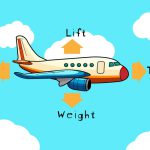Artificial Intelligence (AI) is no longer a futuristic concept—it’s already taking flight in today’s aircraft. 🛩️ From enhancing safety to streamlining operations and even piloting drones, AI is revolutionizing the way we fly. Whether you’re a frequent flyer, aviation enthusiast, or aspiring pilot, understanding the role of AI in modern aviation gives you a front-row seat to the next era of air travel.
In this in-depth article, we’ll explore how AI is integrated into various facets of aviation, its real-world applications, benefits, and what the future holds for autonomous skies. 🌐✈️📡
🚀 What is Artificial Intelligence in Aviation?
Artificial Intelligence refers to computer systems that can perform tasks typically requiring human intelligence. These include problem-solving, decision-making, learning, and adapting. In aviation, AI is used to process massive data, optimize systems, and make real-time decisions—all with speed and precision far beyond human capacity.
🧠 Key Areas Where AI is Used in Airplanes
Let’s break down the major ways AI is currently being utilized in modern aircraft systems:
🛠️ 1. Predictive Maintenance
AI is transforming how aircraft are maintained. Traditionally, airplanes were serviced on fixed schedules or after a problem occurred. With AI, airlines can predict when a component is likely to fail—before it actually does!
🔍 How It Works:
-
Sensors collect data from engines, hydraulics, and avionics.
-
AI algorithms analyze patterns and detect anomalies.
-
Maintenance teams receive alerts for potential failures.
💡 Benefits:
-
Reduces unplanned downtime.
-
Saves money on unnecessary maintenance.
-
Increases aircraft availability and safety.
🧪 Example: Rolls-Royce uses AI in its “IntelligentEngine” system to monitor engine health in real-time.
🧭 2. Autopilot and Autonomous Flight Systems
Autopilots have been used for decades, but with AI, they are becoming increasingly autonomous and intelligent.
🤖 What AI Adds:
-
Learns from historical flight data and adapts to changing weather.
-
Makes real-time decisions for smoother, safer flights.
-
Can assist in landing or even fly the entire flight without human intervention (under development).
✈️ Autonomous Aircraft & UAVs (Unmanned Aerial Vehicles):
AI powers drones and autonomous air taxis by:
-
Mapping surroundings with computer vision.
-
Avoiding obstacles and following dynamic flight paths.
-
Making independent navigation decisions.
🌐 Projects like Airbus’ ATTOL (Autonomous Taxi, Take-Off, and Landing) have already demonstrated AI-controlled autonomous flight capabilities.
🧑✈️ 3. AI in Cockpit Decision Support
Pilots are faced with vast amounts of information during a flight. AI-based systems act as intelligent copilots, assisting human pilots in making complex decisions.
📋 AI Functions in the Cockpit:
-
Suggests optimal routes based on weather and air traffic.
-
Assesses risk in emergencies (e.g., system failures).
-
Provides real-time alerts and alternative solutions.
🎛️ Tools like Honeywell Forge and IBM Watson are being integrated into cockpit systems to support decision-making with intelligent insights.
📡 4. Air Traffic Management (ATM)
Airspace is becoming increasingly congested. AI helps manage traffic flow safely and efficiently.
🔗 AI Contributions to ATM:
-
Predicts traffic patterns and potential bottlenecks.
-
Assists in conflict detection and resolution.
-
Helps in automating tower and en-route air traffic controls.
🛬 Eurocontrol and NASA are both using AI to test smarter air traffic control systems that reduce delays and improve safety.
🧳 5. Passenger Experience Enhancement
While not inside the cockpit, AI is improving passenger services, which are part of the complete aviation experience.
💺 AI in the Passenger Journey:
-
Chatbots for booking, check-in, and FAQs.
-
Facial recognition for faster boarding.
-
Smart in-flight systems that adjust lighting or suggest meals based on preferences.
🛫 Airlines like Emirates and Delta are already deploying AI in their customer service operations to enhance passenger satisfaction.
🧮 Real-World Examples of AI in Aviation
Here are some companies and projects leading the AI revolution in aviation:
| Organization | AI Application |
|---|---|
| Boeing | SkyGrid platform for autonomous drone routing |
| Airbus | ATTOL autonomous flight system |
| GE Aviation | Predictive maintenance using AI analytics |
| NASA | UAM (Urban Air Mobility) traffic management |
| Rolls-Royce | IntelligentEngine with real-time AI diagnostics |
⚖️ Benefits of Using AI in Aviation
✅ Safety Improvements: AI can detect threats faster than humans.
✅ Cost Efficiency: Predictive maintenance and route optimization save fuel and maintenance costs.
✅ Reduced Pilot Workload: Assists pilots, reducing fatigue and human error.
✅ Environmental Benefits: Smarter route planning reduces carbon emissions.
✅ Enhanced Passenger Experience: Personalized services, faster boarding, and improved communication.
🧱 Challenges and Considerations
AI, despite its advantages, presents unique challenges:
⚠️ Reliability: AI systems must be rigorously tested for safety.
⚠️ Ethical Concerns: Should AI be allowed to fly without human intervention?
⚠️ Cybersecurity: AI systems are vulnerable to hacking and data manipulation.
⚠️ Pilot-AI Coordination: Training is needed to ensure pilots can effectively work with AI.
⚠️ Regulatory Hurdles: Global aviation authorities must develop frameworks for AI use.
🔮 Future of AI in Aviation
As AI matures, we can expect even smarter autonomous aircraft, fully automated air traffic control, and AI copilots that learn from every flight.
🛸 Imagine a future where:
-
Planes fly themselves entirely on long-haul routes.
-
AI systems self-correct mid-flight issues before humans notice.
-
Drone taxis become as common as Uber rides.
But this future also requires collaboration between tech developers, regulators, pilots, and engineers to ensure safety, ethics, and public trust.
📌 Conclusion: A Smarter Sky Awaits
Artificial Intelligence is reshaping the skies—making aviation safer, smarter, and more efficient. From deep-learning-powered cockpit assistants to self-monitoring engines and even autonomous aircraft, AI is not just an enhancement—it’s a transformation. 🌍✈️💡
For students, professionals, and aviation fans, understanding AI’s role in airplanes opens up a world of opportunities to innovate, learn, and be part of a cutting-edge industry.

